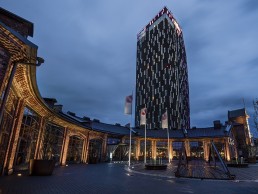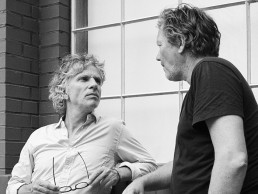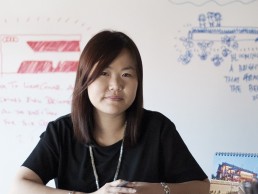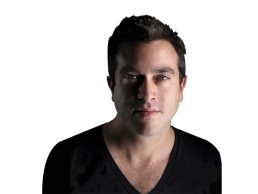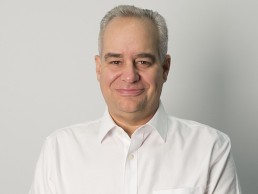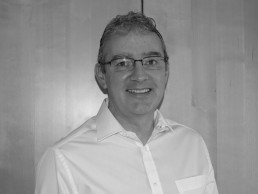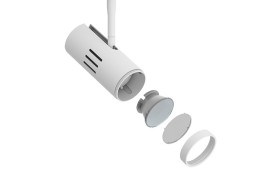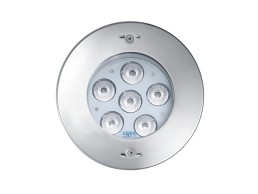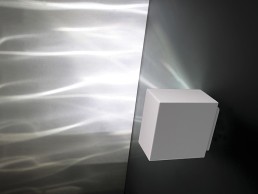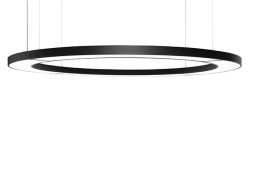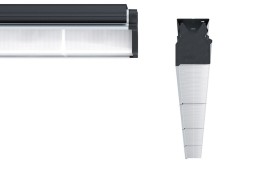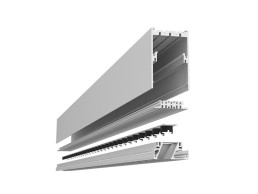Solo Sokos Hotel, Finland
Having won this year's Finnish Lighting Award, the façade lighting of Solo Sokos Hotel Torni in Tampere, shines brightly among the winter darkness, reflecting the dynamic urban atmosphere that surrounds it.
With just a few hours of daylight a day during the winter months in Scandinavia and Finland, artificial lighting has an extremely important role to play in the mental state of its inhabitants. With this in mind, when illuminating the façade of the Solo Sokos Hotel Torni Tampere, the expectations on the lighting design were high.
While the hotel’s commercial operator Sokotel initially wanted the building to look as though it had just been transported from Las Vegas or Times Square, the city architects were hesitant; lighting a tower hotel to such a level would significantly effect the cityscape and the image of the city during dark periods and so the task was to find a lighting solution for both.
It was decided that the lighting should, in a modern and harmonic way make the hotel building come alive while brightening the city’s image at the same time. It had to fit in with citizens’ everyday life yet reflect the dynamic and urban atmosphere of the city. While Finland is mainly a country of low urban architecture, in contrast the hotel is a significant landmark in the City of Tampere. Found on the former train depot, it can be seen from any point in the city and in turn modifies the cityscape seen from almost every street view.
The hotel consists of two parts. The restaurant and congress premises are located in the lower part - historically valuable old locomotive stables, with the building representing traditional red brick architecture typical for Tampere region. A new tower building as a contrary, represents modern high-glass Finnish architecture. The old building has been highlighted in a very traditional and simple way. The lighting for the hotel yard was designed to be detailed. The main idea was to open views to the interior spaces and also leave room for dramatic darkness.
For the tower section many alternatives were considered. It had to combine architecture, cityscape and commercial viewpoints. The solution was to highlight the architectural facet in a sophisticated way by giving a little bit of liveliness and delicate change to the tones of the lighting used.
The idea behind the upper part of the tower was taken from the architecture, as the building is characterised by the rhythm of steel elements. This same rhythm was repeated with the media panels placed around the building at its top. The media facade has 360º of visibility and as such has become a dynamic, yet harmonic part of the cityscape.
As the lighting design process advanced, it led to the creation of light art Signal, bringing the media façade and architectural facet lighting together. Despite media panels being separate from each other they still work together coherently, with the design idea to show only abstract movement of light on the media surface. While the steel elements reflect the sunlight in various cardinals in dark periods, the media surface aims to reflect natural light and everyday life, changing according to the day of the week, whether it is night or day, depending on the seasons, festivals and national holidays.
This award-winning project is an example of how modern technology can be applied as part of the city's architecture and scenery. The media façade draws the urban landscape in harmoniously, standing as a signal to the surrounding areas and enlivening the cityscape. In dark periods, every hour, the flammable light show spices things up in the city.
The building has become a unique and famous attraction in the country, with many tourists, construction professionals and architects making excursions to see this rewarded installation. The hotel has also become a popular destination for weekend travellers and a good reason to get to know Tampere, the largest inland city in Scandinavia – tourism in winter has particularly been boosted thanks to the addition of the hotel, which is consistently booked up.
Pic: Juhana Konttinen
Snøhetta
Since 1992, the Zumtobel Group has commissioned renowned designers to give artistic expression to its annual reports. The 2013/14 report by Snøhetta was recently the subject of an exhibition at Aedes Architecture Berlin. Henrietta Lynch caught up with the Norwegian architects to explain the concept and their fascination with natural light.
Living the Northern Light was the title of an inspiring and magical exhibition hosted by Aedes Architecture Forum in Berlin from 08 August – 01 October 2015. The exhibition documented the 2013/14 Zumtobel Annual Report and featured four 3m x 4.5m stunning, high resolution, black and white portrait photographs of people over 100 years in age who were born and live (or lived at the time of the report) within the Arctic Circle.
The portrait photographs acted as banners for the exhibition and a psychological link appealing to visitors; enticing them to explore further. Beate Engelhorn the Aedes curator of the exhibition was amazed at how well they worked to attract people, commenting that “...when we were constructing the exhibition, people working around the Aedes complex were immediately drawn to the portraits and wanted to know what they were all about.”
The 23rd and 2013/14 Zumtobel Artistic Annual Report was produced by Norwegian architects and designers Snøhetta, an international architecture, landscape architecture, interior architecture and graphic design firm founded in 1989 - named after one of Norway’s highest mountain peaks and are based in Oslo and New York.
The theme of the report is described by Zumtobel Group CEO Ulrich Schumacher as being “a very special take on the fascination of natural light” in which the readers are invited to “discover the phenomenon of light in the arctic circle; with its never ending summer days and long winter nights, all the way to the mysterious northern lights.”
The report features interviews with four main protagonists who were the subjects of the portraits; two being Swedish nationals and the other two Norwegians. The geographical co-ordinates used under the photographs are the geographic co-ordinates for the home locations of the four; Olaug Bastholm (70˚51’28’’N,29˚5’5’’E), born 06 February 1914 in Berlevåg, Finnmark Norway, Marie Gulbrandsen, (69˚8’48’’N,18˚9’22’’E) born 30 September 1912 in Sørreisa in Troms, Norway (sadly now deceased), Apmut-Ivar Knolijok, (66˚37’0’’N, 19˚50’0’’E) born 22 March 1928 in Nautijaur, Sweden and Helny Zingmark , (65˚50’0’’N, 21˚43’ 0’’E), born 28 July 1913 in Boden, Sweden.
Using the subject’s stories combined with additional artwork including portrait busts made of the characters, the documentation of three of Snøhetta’s architectural projects; Lofoten Opera Hotell, Norwegian Wild Reindeer Pavilion and Bjellandsbu; and results of scientific research, the report examines the special experiences of living above the Arctic Circle. With all this taking the extreme natural lighting conditions and the vast social-political changes that have occurred there over the last hundred years into consideration.
The Arctic Circle is an imaginary line of latitude at 66˚33’. Approximately four million people live above the Arctic Circle in climatic conditions that include 24 hour daylight during the summer months and almost complete darkness, known in Norway as ‘Mørkertid’, between the end of November and the end of January every year. These conditions also include very low levels of solar irradiation in comparison to most other global locations, extreme cold and harsh weather, meaning that no full sized trees can grow there but beautiful and ethereal events such as the Aurora Borealis or Northern Lights occur.
The report tries to gain an understanding of what makes people who live in the far north and in such extreme conditions different from other people, if at all. It is also an exploration of the actual lighting conditions using established research and data gathered from in-situ light sensors. Most intriguingly it is an insight into the psyche and behaviour of residents of this polar region.
Due to the natural bias of Norwegian architects Snøhetta, boundaries to the report were drawn with a focus on the residents of the Arctic Circle from Norway and Sweden. Of the people who live within the Arctic Circle, approximately 10% are Norwegians. This in turn makes up about 10% of the Norwegian population. More Norwegians live in this region than Swedes due to different government demographic polices over the last century. Many members of this population are originally from ethnic Sammi communities who worked, and still, to an extent work as nomadic reindeer herders. In previous times, this indigenous population experienced various forms of racial discrimination from the different Scandinavian governments. All the residents lived subsistence level lifestyles until the mid-twentieth century with few possessions and little money and had to work closely with the natural environment to survive.
One of the most interesting facts about the four featured protagonists from this extreme environment is that they were all born, and initially grew up, without electric lighting and grid supplied power. Instead they were reliant on kerosene lamps and heating provided with fuel from local sources. During their lifetimes, they saw the introduction of electrical supply and the development of various types of new infrastructure, including for water and communications, and the provision of food and new types of commodities.
Snøhetta founding member Kjetil Trædal Thorsen saw these people’s experiences as a valuable record of social development over the last century, and key to the report and exhibition content as a whole.
“People born in the beginning of the last century are the last living generation to have experienced changes that have had a tremendous physical impact on the humanity in the Western world.”
Snøhetta as architects and designers are fascinated by the way that people live, work and evolve over time, and within their environments and surrounding landscapes. This fascination has helped to shape their design projects over the years and was an inspiration for their work with Zumtobel. Within this context, Thorsen sees the human ageing process as the development of expertise and particularly inspirational. “Our inspiration is the fact that age has become a kind of expertise,” he says.
Thorsen also sees the processes of time and human experience working to help sculpt space and form design.
“Time is an integral part of any human light/space/landscape experience. Lived time is the manifestation of continuous relationships between sequential events and the fluctuating conditions of the physical surroundings influencing those events.”
Thorsen worked together with Senior Director Greger Ulf Nilson and the Snøhetta team to develop the concept for the Zumtobel report and later the exhibition in Berlin with Aedes.
The architects also chose to work with a team of writers and artists including Åsne Seierstad and Po Tidholm who carried out the interviews with the centenarians; and the Norwegian, but London based, photographer Sølve Sundsbø to produce the portraits.
The portraits are so detailed that they show every line on the character’s faces. The lines and contours work like landscapes and seem to document the life experiences and inner emotional space of the sitters. Thorsen refers to the portraits as being like frozen light.
“The visual expression of each individual was captured in daylight, freezing their faces in a daylit timeframe.”
The portraits work individually or as a series, but their psychological content means that they directly complement the written interviews and architectural design work presented.
The four characters have quite different personalities. This becomes evident when reading the interview texts. They do however share some common experiences and some anxieties about the changes that have taken place over the last century.
Olaug Bastholm, who is still physically very fit and enjoys daily walks, explained that when she grew up, everybody played outside all the time no matter the weather, and that children created their own games and handmade toys. Now she is worried that “the kids don’t go out and play anymore. They’re inside. They’re not able to come up with games on their own. They sit and stare at a screen or push a few buttons. It’s an abomination. What will become of them?”
Whereas Apmut-Ivar Knolijok, who has Sammi origins and is concerned that indigenous Sammi knowledge is now being lost, describes how life used to be different without modern telecommunications.
“Nowadays nobody can manage without a telephone or radio, but in my day you tried to keep track of other families’ migration routes. Sometimes you had to wait for each other for days. It was a little impractical.”
Marie Gulbrandsen, who lived without running water and electricity until 1959, remembers the magical experience of watching the dancing northern lights from her window. She also describes hunger between the wars and the luxurious childhood experience of eating kohlrabi for the first time. She also explained that oil and wicks for lamps and lighting were expensive and to be used carefully.
Helny Zingmark also talks about the previous scarce resources of power and light and how the scarcity worked to bring people together and re-inforce community. “But when the electricity came, we grew apart. The circle of candles disappeared. We could go our own way. The house got bigger.”
The Zumtobel Annual Report 2013/14 is truly a work of reflective genius and definitely worth reading. It is especially poignant when considering how, over the last century, we have sadly learned to need so many things, and take the provision of expensive commodities and power supply for granted. It is also a reflection of the value and wisdom that can come with age and experience, a concept that also often seems to be forgotten, but which is particularly relevant for today’s ageing European and Western populations.
Pic: Ina Niehoff
Toh Yah Li
One of the first professionals to become a Certified Lighting Designer and regional co-ordinator for IALD South East Asia, Toh Yah Li has burst onto the scene since establishing Light Collab in 2010. Robert Such catches up with the bright light in Singapore.
Currently one of just a handful of Certified Lighting Designers (CLD), Toh Yah Li’s work ranges from simple, low-tech lighting installations made from everyday objects like plastic bags to carry drinks (albeit everyday in Toh’s home country, Singapore) or breath mint boxes and matchboxes to commercial and residential interiors. Toh’s work also includes a Chinese temple and a 46-metre-high glass monument. Work on lighting a casino in Malaysia is also underway. “When I started Light Collab, I never imagined I would actually complete a casino project or a monument,” says Toh.
Toh is also currently the regional coordinator for IALD Southeast Asia, organising events to raise awareness about lighting and to engage the public in thinking about light, its effect on perceptions of space and changing the atmosphere of a space.
“We are also interested in the temporal effects of lighting and how temporary light art contributes to the city and public spaces,” says Toh. One such Light Collab installation, We The Light, was part of the Singapore-wide Torch-Up! programme of community art events for the 2015 SEA Games (South East Asian Games). The idea behind the installation was to explore “the possibilities of involving people and communities in the illumination of sculptures, attempting to defy the notion that a sculpture is an object of visual appreciation.”
Collab, a diminutive of ‘collaborators’, refers to the four lighting designers that work together at the firm. Headed by Toh, the Singapore-based design team’s other members are Nicole Ban and Chua Li Qi. The fourth member of the team, Teruhiko Kubota, works on Singapore projects too, but is also in charge of the Light Collab Japanese office.
Since founding Light Collab back in 2010, Toh has worked in a number of countries across Asia, including Japan, Bangladesh, Indonesia, Myanmar and Malaysia. Notable overseas projects include lighting a 46-metre-high (150ft) glass tower, the Tower of Light, built as part of the Liberation War Museum and Independence Monument in Dhaka, Bangladesh.
“Bangladesh was a real experience as I never thought that we could travel to such exotic places; as well as this, being commissioned to design the lighting for the important monument of freedom, which is a symbol of light,” says Toh. “This was one of the most meaningful experiences I’ve had as a lighting designer, as well as the fact that what you design can impact so many people.”
Along with the lighting of the glass tower, the firm’s first job in Japan was also a turning point in Toh’s career. It was a “flagship terminal of an Audi centre in a very prominent location of Yokohama, Minato Mirai,” she says. “The project was meant to be a showcase for the region.”
For Toh, yet another turning point was when the lighting design of the same building - the Audi Minato Mirai - received an IES (Illuminating Engineering Society) Award of Merit and also a Good Lighting Award from the Illuminating Engineering Institute Japan (IEIJ).
The CLD qualification that Toh holds is relatively new. Five years in the planning, the CLD application process opened in 2015. “Until now there has been no official codified definition of the architectural lighting design profession,” says David Becker, lighting designer and Chair of the Certified Lighting Designer Commission (the CLD governing body). Standardising the measurement of competency among lighting designers, the CLD credential “legitimises the profession,” continues Becker. It also “offers the only international, evidence-based benchmark of lighting design competency.”
Drawing on ten year’s working experience, since graduating from the Hochschule Wismar, University of Applied Sciences, Technology, Business and Design in Germany with a Masters in Architectural Lighting Design, Toh spent around a month putting together the necessary documentation for the CLD application. It paid off and “in a field where almost anyone can say they are a lighting designer without first establishing legitimacy, CLD is a mark of proper distinction,” says Becker.
Before moving into lighting design though, Toh studied architecture at the National University of Singapore (NUS). Her initial interest in architecture came partly from “looking at images of the beautiful spaces created by the master architects, and also architects such as Tadao Ando, Antoni Gaudi, Philip Johnson, Mies Van der Rohe,” she says. “The spaces are able to move my heart, because of the way light is filtered or fills the spaces.”
Toh graduated from the NUS with a Bachelor of Arts (Architectural Studies) degree in 2002, and worked in an architectural office in Singapore, until she realised that little attention was being paid to lighting spaces and how the volumes and forms of architecture integrates to give a narration.
Poorly lit spaces were missing something important. “Without it buildings become empty, cold spaces and unfeeling,” Toh says. It was then that she decided to pursue a career in lighting design.
After graduating from the Hochschule Wismar, where she had interned at Stilvi in Athens as part of her studies, Toh joined the Singapore office of Lighting Planners Associates. There, she worked on numerous large-scale projects, such as the National Museum of Singapore and the Peranakan Museum, whose collection explores the Peranakan culture of people of mixed ethnic origins that immigrated to Peninsular Malaysia and Singapore.
Four years later, it was time to move on. Toh taught architectural and lighting related courses at various polytechnics in Singapore. Then in 2010, after talking to Kubota about working together, she started Light Collab. “It happened quite naturally,” she says. Commissioned work came from existing contacts, and “it felt like the right time as well after working with young inspiring students. I was energised.”
Toh also wanted greater freedom to choose which projects to work on and since working for herself, she says: “I can now decide what kind of projects to do. I can try out and test out [things]. Be different.”
Light Collab’s first commissioned assignment was quite different from what she had been used to working on at LPA. Smaller in scale, it involved lighting a house designed by Singapore-based architecture firm K2LD. A referral landed her the job. In fact Light Collab takes part in few competitions. Work comes their way from recommendations.
Since then, work that has come their way includes the firm’s current projects, which, along with the casino, comprise hotels and an office tower in Indonesia, a library in India, and a pedestrian mall in China. What excited Toh about light and lighting back then, when she started her career, still excites her today. She was fascinated by the way “an intangible medium can manifest itself,” she says, “and also affects the way objects [and] spaces are perceived. It is a very magical material.”
And what continues to excite her now is “experimenting with it and finding new ways to use light as a medium,” she says, “and how it interacts and reacts with the spaces, materials and most importantly, people. I am also very fascinated by the way people interact with light and also discover new insights about light, spaces and sometimes, even about themselves, when light connects with them successfully.”
Sakchin Bessette
Having recently opened an office in London to add to their HQ in Montreal and subsidiary in LA, we speak to Moment Factory’s Creative Director Sakchin Bessette about what makes them tick...
How and why did you establish Moment Factory?
Moment Factory began because we were following amazement. In the beginning, I was VJing at nightclubs and raves and at after-hours parties… doing a lot of slideshows in the days before I had access to all the digital equipment and technology available now. One thing led to another and a core group of friends rented a small loft space together, each chipping in a little to pay the rent. Slowly, we started getting more gigs and contracts, with Cirque du Soleil for example; then we got into rock shows and permanent installations. Our studio was born because we were following our passion for visual performance and new styles of storytelling. Perhaps we were also fortunate to be part of a revolution in multimedia arts and at the forefront of something new. Now, we have approximately 150 people working full time at Moment Factory; a multidisciplinary talent pool that collaborates together and cross pollinates.
How would you describe Moment Factory?
Moment Factory is a new media, art and entertainment studio that specialises in creating shows and destinations. ‘we do it in public’ is our motto because we believe in creating engaging experiences in public spaces. Though there are many great companies and people developing customised entertainment for personal devices, Moment Factory is dedicated to creating new types of entertainment in public, where people from all walks of life gather together and cross paths; whether that’s at rock shows, or in a natural landscape, or at airports. What we really care about is connecting people physically to each other through the experiences we create for them.
What has been your favourite project?
It’s hard to choose only one, but I often say that my favourite project is the studio; that is, the people that make up Moment Factory who are learning and growing together and really pushing each other to create completely new experiences.
Ultimately, we learn from one project and we apply it to the next. More and more, we have been taking on turnkey projects: driving the creative, technical design, installation and the operations. We are also taking on permanent infrastructure projects. Therefore, I’m super excited by our project Foresta Lumina, an illuminated trail in the forest where people can journey and discover various installations within a nighttime environment. I’m equally proud of our collaboration with the Tom Bradley International Terminal at Los Angeles International Airport (LAX), which is an outstanding permanent piece; it is very exciting to be able to give birth to something that will last. I feel like we have really pushed innovation in the rock show world by collaborating with various bands, lighting designers, stage designers and show directors. For me, it is extremely motivating to see Moment Factory’s culture grow as the medium and our audiences expand.
You have opened an office in London. What’s the reason?
The choice was a natural one: London is known for being a creative hub and for its cutting-edge entertainment. By opening a new office in London, we are looking to nurture relationships with existing clients, as well as to build new ones in the industry with partners, freelancers and local providers.
Who is heading the office and what’s their background?
The new office is headed up by Simon Lupini, who has many years’ experience working in the entertainment and events industries both in the UK and abroad, for example as the Head of Events for the Royal Albert Hall and as the Company Manager for Cirque du Soleil. Simon was a producer on Moment Factory’s first original theatrical and multimedia show on board the Royal Caribbean International’s new ship, the Quantum of the Seas. At the London office, he will soon be joined by a creative director.
You recently gave the keynote address at IALD’s Enlighten Americas conference in Baltimore. How did you find the experience?
It was a great opportunity to be among talented, knowledgeable and amazing individuals who have been the force behind iconic architectural lighting design projects. We had really great discussions. It’s not every day that I have the opportunity to be in the company of so many people who are as passionate as I am about light.
What do you think the professions of lighting design and multimedia arts could learn from each other?
I have always been fascinated by light and amazed by its mysteries. However, sometimes as lighting professionals we see light as something scientific; as something that has lumens and brightness and colour and shape, not as something that is magical and fundamental to life. At Moment Factory, we don’t work necessarily with code specifications and safety requirements, for example with respect to light intensities in public spaces; we work with light for entertainment and to create emotion for people.
So, there is a difference between how we use light as a medium and how architectural lighting designers use light as a medium. However, these are definitely complementary disciplines. I am in this industry because of my fascination with light and I think it’s important to collaborate with all kinds of lighting designers.
That’s why when we were commissioned to illuminate the Jacques Cartier Bridge in Montreal, a project that will launch in 2017, we invited a group of independent lighting designers to work with us. So far, this collaboration, while at times challenging, has proved rewarding because our collaborators have brought to the table a whole different set of approaches and points of views.
Jaime Friedstadt joins Chauvet
(USA) - Experienced in entertainment and architectural lighting industries, Friedstadt joins as Director of Business Development & Marketing for CHAUVET Professional and Iluminarc divisions in Hispanic markets.
Chauvet has announced the appointment of Jaime Friedstadt as Director of Business Development & Marketing for Hispanic Markets for the company’s CHAUVET Professional and Iluminarc divisions. Prior to joining Chauvet, Friedstadt was International Sales Manager of Philips Entertainment. Having been with that company since 2001, he managed Latin American sales of all Philips Entertainment brands, including Vari-Lite, Strand Lighting, Selecon and Showline. Earlier in his career, he was Latin American Sales Manager of Hubbell Lighting.
“The experience Jaime brings to this position dovetails very nicely with our vision of Chauvet’s future in the Latin American market,” said Albert Chauvet, President and CEO of Chauvet. “Jaime has a keen understanding of the lighting industry and of Latin American business culture. His experience in sales, marketing and business development will help us build on the momentum we’ve already established in this region for Chauvet and our dealer network.”
Friedstadt will report to Stephane Gressier, International Sales Director of Chauvet. “We’re excited to work with Jaime to strengthen and build client relationships throughout the Hispanic market,” said Gressier.
“I’ve been deeply involved in the entertainment and architectural lighting business throughout Latin America for a number of years,” said Friedstadt. “Joining an innovative and rapidly growing company like Chauvet is an excellent opportunity. I am excited to get started!”
Casambi expands to UK
(UK) - Stephen Jackson, previously of Zumtobel Group, joins as Business Manager to set up organisation in UK and Ireland.
Casambi Technologies, the Finnish company specialising in software driven lighting controls, is expanding to the UK market.
Stephen Jackson, previously Sales Director Controls & Systems for Northern Europe at Zumtobel Group, has joined Casambi and will set up an organisation in the UK and Ireland as the Business Manager.
Commenting on the expansion, Casambi’s managing director Timo Pakkala said: ”After our success in Central Europe we see it as the next obvious step to expand to the UK and Ireland markets. We felt it was time to have a direct sales organisation and support structure since our customer base in the regions is growing fast.”
Jackson commented: “I strongly believe that wireless software solutions is the next technological step in lighting controls. I am thrilled and honored to join Casambi and play a role in bringing this state of the art technology to the UK and Ireland markets.”
Casambi’s product development is carried out in Espoo, Finland, with sales offices previously in Finland and Germany.
EcoSense acquires Journée
(USA) - Acquisition of privately owned, California-based lighting company allows EcoSense entrance into downlight and track lighting market.
EcoSense, a fast-growing LED technology company, announced today that it has acquired the assets of Journée Lighting. Journée Lighting is a privately owned, CA-based lighting company that specialises in the design and development of specification grade lighting.
EcoSense and Journée both share similar product development and innovation philosophies, which led to a natural fit between the two companies. Founded in 2005 by serial entrepreneur Clayton Alexander, Journée has become known for its many innovations in LED technology, including significant patents ranging from component-level to system-level solutions. This acquisition allows EcoSense to enter the downlight and track lighting market and leverage Journée’s IP for future product development efforts.
“Journée’s specifier-grade product portfolio is a great complement to our brand,” said Mark Reynoso, CEO of EcoSense Lighting. “Further, its significant IP portfolio will enable us to expand our product offering in interesting ways.”
“We are thrilled to partner with EcoSense and leverage its key strengths, including new technology development, manufacturing efficiencies and global sales expertise,” said Clayton Alexander, CEO of Journée Lighting.
Wibre SwimmingPool-Light 4.0199
The special RGB-W LED boards have now been launched in the Swimming pool spotlight 4.0199. Suitable for medium-sized pools, they have now become even more individual in terms of colouring in the water. Six RGB-W multichips in a circular arrangement are used. There will be versions without optics but with a scatter disc and versions with optimised mixing lenses, in which the four colours are mixed into the optics directly after the LED. This creates a very even colour distribution. The following assemblies are available: RGB cold white, RGB warm white, RGB neutral white and RGB amber.
Radiant Water Effect Light
This wall-mounted luminaire incorporates a series of white LEDs with different colour temperatures run by a four-channel DMX controller which, in combination with a rippled glass panel, creates a slowly changing effect of light reflected from flowing water. Available in IP20 and IP65 versions and in two sizes.
XAL UFO
UFO is an impressive luminaire with a special style. The space-defining character of the ceiling-mounted or suspended shapes gives rooms a singular flair. In addition to its elegant design, this extravagant luminaire is one thing in particular: exceptionally practical. Thanks to an anti-glare rating of UGR <19, UFO is ideal for lighting workplaces. As an option, the ring-shaped arrangement can be fitted with soundproofing elements.
ERCO Lightgap
With the new Lightgap grazing light wallwasher, ERCO now offers an innovative indoor LED lighting tool for qualitative lighting design with stunning effects. The recessed luminaire emits remarkably linear light that brings out the finest surface structures and textures for an almost three-dimensional effect. With unprecedented precision and uniformity, the new lighting tool lives up fully to ERCO's maxim of 'light digital'.
Vice Lighting U060
The U060 cut-off washer marks a breakthrough in wall washing illumination offering surface uniformity while blocking the backward and longitudinal throw (no light spill) and maintaining strong power and efficacy. It is glare and light pollution free and designed to be highly configurable, adapting to a wide variety of commercial and architectural building types used in both interior and exterior lighting concepts.


